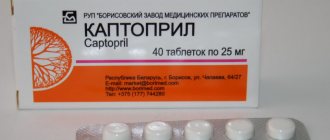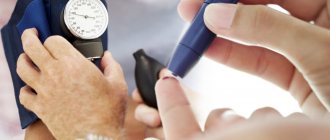The role of histamine in allergic reactions
Histamine is a biologically active substance produced by the body to regulate vital functions (blood circulation, respiration, digestion). It is concentrated in mast cells, white blood cells that are part of the immune system.
Under normal conditions, there is little histamine in the human body and it is inactive. But when certain substances enter the body, their active production begins. When the allergen binds to immunoglobulin, mast cells degranulate (release substances that cause an inflammatory response). Histamine is released, leaves the cells, and the body comes under its influence. It causes:
- hives;
- swelling of the mucous membranes;
- bronchospasms;
- decreased blood pressure;
- digestive disorders;
- confusion;
- slowing down the conduction of nerve impulses.
The first three reactions are allergic. They are the immune system's response to contact with an irritant. Most allergic reactions develop immediately.
Mechanism of action of H2 blockers and indications for use
Histamine (H2) cell receptors are located on the membrane inside the stomach wall. These are parietal cells, which in the body are involved in the production of hydrochloric acid.
Its excessive concentration causes disturbances in the functioning of the digestive system and leads to ulcers.
Substances contained in H2 blockers
, tend to reduce the level of gastric juice production. They also inhibit ready-made acid, the production of which is triggered by food consumption.
Blocking histamine receptors reduces the production of gastric juice and helps cope with pathologies of the digestive system.
Due to the effect they have, H2 blockers are prescribed for the following conditions:
- ulcer (both stomach and duodenum);
- stress ulcer - caused by severe somatic diseases;
- an ulcer that occurs due to long-term use of non-steroidal anti-inflammatory drugs or corticosteroids;
- acute pancreatitis and exacerbation of chronic;
- in combination with pancreatic enzyme preparations, in order to protect them from the destructive effects of gastric juice.
The dosage and duration of taking H2-antihistamine drugs for each of the listed diagnoses is prescribed individually.
What can trigger an increase in histamine?
Allergens are substances that provoke increased release of histamine. Medicine has studied many allergens that can be divided into such groups.
Exogenous infectiousExogenous non-infectiousEndogenousVirusesFoodProtein-containing compounds that make up the cells of the bodyBacteriaPolenFungiIndustrialHouseholdMedicinal
Endogenous allergens are produced by the body itself. They cause autoimmune diseases (attacks of the immune system on healthy tissues).
Exogenous ones enter the body from the environment - through food, plant pollen, house dust. Industrial allergens include a variety of chemicals (dyes, cleaning products, fragrances).
Features of the use and dosage of H2-histamine blockers
Drugs in this group are prescribed individually, based on the diagnosis and degree of development of the disease.
The dosage and duration of therapy are determined based on which group of H2 blockers is optimal for treatment.
Entering the body under the same conditions, the active ingredients of drugs of different generations are absorbed from the gastrointestinal tract in different quantities.
In addition, all components differ in efficiency.
| Active substance | Absorption when taken orally (in%) | Equivalent dosages of the substance (in mg) | Duration of suppression of hydrochloric acid production at night (in hours) | Frequency of side effects (in% of cases) |
| Cimetidine | 65-85 | 800-1000 for 3 doses per day | 2,5-5 | 3,2 |
| Ranitidine | 45-60 | 200-300 for 2-3 doses | 7-10 | 2,7 |
| Famotidine | 30-60 | 40 for 1-2 doses | 10-12 | 1,4 |
| Nizatidine | 75-100 | 300 for 1-2 doses | 10-12 | Very rarely |
| Roxatidine | 90-100 | 75-150 for 1-2 doses | 13-16 | Very rarely |
According to general recommendations, H2 blockers are contraindicated in people with hypersensitivity. They should be taken with particular caution in case of chronic heart or kidney failure, pathologies of the hematopoietic organs, as well as children under 16 years of age, pregnant and nursing mothers.
Symptoms of an allergic reaction
A wide range of symptoms is known, but this does not mean that the same clinical picture occurs upon contact with all allergens. Depending on the type of hypersensitivity, the body reacts differently:
- atopic: rhinitis, conjunctivitis, dermatitis, asthma, Quincke's edema;
- reagin: inflammation of the mucous membranes, autonomic disorders;
- cytotoxic immune: damage to cells and tissues (immune thrombocytopenia, hemolytic anemia, etc.);
- immunocomplex: inflammation of joints, kidneys, skin manifestations.
There are also delayed-type reactions that do not make themselves felt immediately upon contact with the irritant. After two days, the allergen combines with lymphocytes, which leads to the development of an infectious-allergic disease, for example, chronic neurodermatitis.
How to eliminate allergy symptoms
The more free histamine is released, the more severe the allergic reaction. In some cases it causes inconvenience (constant sneezing, itchy eyes), in others it poses a threat to life (with bronchospasm a person cannot breathe). You can stop the reaction:
- stopping contact with the allergen;
- neutralizing histamine with an antihistamine;
- symptomatic therapy (for example, inhalation to immediately expand the lumens of the bronchi).
In the event of the development of anaphylactic shock, accompanied by a decrease in blood flow and laryngeal edema, it is important to promptly eliminate the threat to life. The set of measures includes the administration of adrenaline and ensuring air flow into the lungs (intubation).
Types of antihistamines
First-generation drugs could block histamine receptor signals only after penetrating the barrier between the circulatory and central nervous systems. As a result, the effects on the central nervous system could not be avoided. Because of this, antihistamines caused drowsiness and loss of coordination.
Pharmacologists took this shortcoming into account when creating second-generation drugs. They do not penetrate the mentioned barrier, act selectively, and do not have a sedative effect.
Third generation antihistamines are metabolites of their predecessors. They give the same effect at a lower dosage and do not affect the functioning of the cardiovascular system. However, some allergists and immunologists do not agree with separating them into a separate group and classify them as the second generation.
In 2015, the Consensus working group on new generation antihistamines led by Professor S.T. Holgate concluded that none of the existing drugs can be classified as third generation.
Examples of AGPs of different generations
AGP 1st generationAGP 2nd generationAGP 3rd generation*DiphenhydramineLoratadineCetirizineTavegilClaritinZyrtecSuprastinKestinCetrinDramamineVisin and Tizin AllergiTelfastDiazolinAllergodilFexofenadineAtarkcFenistilAllerfex
*according to supporters of their existence
II generation H1 blockers
Second generation antihistamines were developed to overcome the shortcomings of their predecessors. Unlike the latter, modern H1 blockers bind and dissociate from H1 receptors slowly. Due to their long-term connection with histamine receptors, they are able to provide a long-lasting effect, allowing them to be used 1-2 times a day. It has been proven that with regular use of all second-generation drugs for a month, their therapeutic response does not decrease, that is, tachyphylaxis does not develop.
Indications
Non-sedating antihistamines are the first-line treatment for mild to moderate forms of allergic rhinitis. They are appropriate to recommend to clients with minor symptoms of allergic diseases, as well as moderate allergies.
Advantages
Being comparable to the first H1 blockers in terms of antiallergic activity, representatives of the second generation do not exhibit sedation and many other adverse reactions, which is associated with their high selectivity and significantly lower ability to penetrate the blood-brain barrier.
The advantages include long-lasting action, the possibility of single use per day, and the absence of tachyphylaxis.
Portability
Despite the obvious advantages, some second-generation drugs have a rare but serious side effect - the ability to cause heart rhythm disturbances in the form of prolongation of the QT interval, development of ventricular arrhythmias), atrioventricular block and bundle branch block. Such arrhythmias are manifested by episodes of dizziness and fainting, but can often be asymptomatic.
The cardiotoxic effect is dose-dependent. When using drugs in therapeutic doses, arrhythmogenic properties practically do not appear. This is due to the fact that most second-generation antihistamines are prodrugs that are almost undetectable in the bloodstream due to rapid biotransformation with the formation of active and long-acting metabolites. It should be noted that the biotransformation of second generation antihistamines occurs with the help of the isoenzyme of the cytochrome P450 system, the activity of which can be inhibited by some drugs, in particular, ketoconazole, itraconazole, fluoxetine, a flavonoid contained in grapefruit juice and a number of others.
In case of overdose, increased concentration of the prodrug in the blood, as well as conditions in which the rate of biotransformation of the drug decreases (for example, cirrhosis of the liver, simultaneous administration with drugs that inhibit the activity of the cytochrome P450 system isoenzyme), the severity of the cardiotoxic effect of second-generation H1 blockers increases. Additional risk factors include pre-existing long QT syndrome, concomitant use of drugs with arrhythmogenic activity, and electrolyte disturbances.
At the same time, when used correctly, following the dosage regimen and contraindications, second generation antihistamines are well tolerated and can be considered safe for the treatment of allergic diseases.
Loratadine, both the drug itself and its active metabolite, as well as desloratadine and fexofenadine, do not have arrhythmogenic properties. By the way, the latter are not metabolized with the participation of the isoenzyme of the cytochrome P450 system and do not enter into drug interactions with drugs that inhibit its activity.
What should you warn the client about?
When dispensing drugs of this subgroup, it is important to recall the need to adhere to the dosage regimen in order to avoid the development of side effects, in particular, cardiotoxicity.
In addition, it is appropriate to draw the client’s attention to the fact that second generation antihistamines should not be taken simultaneously with drugs that compete with them for hepatic metabolism (ketoconazole, itraconazole, ranitidine, fluoxetine and others).
Features of the action of antihistamines
First generation antihistamines are not limited to suppressing the activity of the central nervous system. They block receptors for various neurotransmitters, not just histamine, and therefore have a number of side effects:
- increased heart rate;
- nausea and vomiting;
- increased eye pressure;
- stomach pain;
- urinary disturbance;
- dry mucous membranes.
With prolonged use, the patient may lose weight, become overexcited, and lose consciousness. In case of overdose, convulsions are possible.
Second-generation antihypertensives act more selectively, and therefore their use does not cause undesirable reactions from organs other than the heart. Patients should consider the risk of sinus and reflex tachycardia, as well as arrhythmias.
Antihistamines and the stomach
Histamine itself activates the production of gastric juice. Therefore, there is an opinion that blocking it inhibits secretion. This is not entirely true. H1 blockers are used to relieve symptoms of an allergic reaction. H2 blockers can reduce the production of gastric juice:
- Cimetidine;
- Ranitidine;
- Famotidine;
- Roxatidine.
This is another group of antihistamines used to treat gastritis, gastric ulcers, and reflux esophagitis. Allergy sufferers do not use them. Therefore, there is no risk of disrupting digestion in an attempt to combat hives or conjunctivitis.
H2-blockers of histamine receptors
H2-histamine receptor blockers
(eng.
H2-receptor antagonists
) - drugs intended for the treatment of acid-dependent diseases of the gastrointestinal tract. The mechanism of action of H2 blockers is based on blocking H2 receptors (also called histamine) of the lining cells of the gastric mucosa and, for this reason, reducing the production and flow of hydrochloric acid into the lumen of the stomach. Refers to antiulcer antisecretory drugs.
Types of H2 blockers
The Anatomical Therapeutic Chemical Classification (ATC) in section “A02 Drugs for the treatment of diseases associated with acidity disorders” contains the group: A02BA H2-histamine receptor blockers
A02BA01 Cimetidine A02BA02 Ranitidine A02BA03 Famotidine A02BA04 Nizatidine A02BA05 Niperotidine A02BA06 Roxatidine A02BA07 Raniti dyne bismuth citrate A02BA08 Lafutidine A02BA51 Cimetidine in combination with other drugs A02BA53 Famotidine in combination with other drugs
By Order of the Government of the Russian Federation of December 30, 2009 No. 2135-r, the following H2-histamine receptor blockers are included in the List of vital and essential medicines:
- ranitidine - solution for intravenous and intramuscular administration; injection; film-coated tablets; film-coated tablets
- famotidine - lyophilisate for preparing a solution for intravenous administration; film-coated tablets; film-coated tablets.
From the history of H2-blockers of histamine receptors
The history of H2-histamine receptor blockers begins in 1972, when, under the leadership of James Black, in the laboratory of Smith Kline French in England, after overcoming initial difficulties, a large number of compounds similar in structure to the histamine molecule were synthesized and studied.
Effective and safe compounds identified at the preclinical stage were transferred to clinical trials. The first selective H2 blocker, burimamide, was not effective enough. The structure of burimamide was slightly changed and a more active methiamide was obtained. Clinical studies of this drug showed good efficacy, but unexpectedly high toxicity, manifested in the form of granulocytopenia. Further efforts led to the creation of cimetidine. Cimetidine successfully underwent clinical trials and was approved in 1974 as the first selective H2 receptor blocker drug. This played a revolutionary role in gastroenterology, significantly reducing the number of vagotomies. For this discovery, James Black received the Nobel Prize in 1988. However, H2 blockers do not have complete control over blocking the production of hydrochloric acid, since they affect only part of the mechanism involved in its production. They reduce secretion caused by histamine, but do not affect secretion stimulants such as gastrin and acetylcholine. This, as well as side effects, the effect of “acid rebound” upon withdrawal, guided pharmacologists to search for new drugs that reduce gastric acidity (Khavkin A.I., Zhikhareva N.S.). The figure on the right (A.V. Yakovenko) schematically shows the mechanisms of regulation of the secretion of hydrochloric acid in the stomach. The parietal cell is shown in blue, G is the gastrin receptor, H2 is the histamine receptor, M3 is the acetylcholine receptor.
Still from video Berezhnaya I.V., Kamlygina M.V. Proton pump inhibitors. SIBO as a complication. In the second part of the video M.V. Kamlygina talks about the history of the discovery of histamine, H2-blockers of histamine receptors, and proton pump inhibitors.
H2 blockers are relatively outdated drugs
| Comparison of daily antisecretory activity of H2 receptor blockers (ranitidine) and omeprazole (Maev I.V. et al.) |
H2-blockers in all pharmacological parameters (acid suppression, duration of action, number of side effects, etc.) are inferior to a more modern class of drugs - proton pump inhibitors, however, in a number of patients (due to genetic and other characteristics), as well as for economic reasons , some of them (mostly famotidine, to a lesser extent ranitidine) are used in clinical practice.
Of the antisecretory drugs that reduce the production of hydrochloric acid in the stomach, two classes are currently used in clinical practice: H2-blockers of histamine receptors and proton pump inhibitors. H2 blockers have a tachyphylaxis effect (a decrease in the therapeutic effect of the drug when taken repeatedly), but proton pump inhibitors do not. Therefore, proton pump inhibitors can be recommended for long-term therapy, but H2 blockers cannot. In the mechanism of development of tachyphylaxis, H2 blockers play a role in increasing the formation of endogenous histamine, which competes for H2 histamine receptors. The appearance of this phenomenon is observed within 42 hours from the start of therapy with H2-blockers (Nikoda V.V., Khartukova N.E.).
In the treatment of patients with ulcerative gastroduodenal bleeding, the use of H2-blockers is not recommended; the use of proton pump inhibitors is preferable (Russian Society of Surgeons).
The time within a day during which intragastric acidity rises above 4.0 pH when taking common medications. O60, omeprazole, 60 mg once daily. O30, omeprazole, 30 mg once daily. O20, omeprazole, 20 mg once daily. R3N, ranitidine, 300 mg at bedtime. R150, ranitidine, 150 mg twice daily. F40, famotidine, 40 mg at bedtime. C8N, cimetidine, 800 mg at bedtime. C4Q, cimetidine, 400 mg four times daily. C4B, cimetidine, 400 mg twice daily. C1G, cimetidine, 200 mg 3 times a day and 400 mg at bedtime. ANT, antacid, 150 mmol seven times daily (Bell NJV, Burget D, Howden CW, 1992).
Still from the second part of the video Berezhnaya I.V., Kamlygina M.V. Proton pump inhibitors. SIBO as a complication.
Frame “Mechanism of action of H2-blockers of histamine receptors” from a video lecture for 3rd year students of the Faculty of Medicine of PSPbSMU named after. acad. I.P. Pavlova: Melnikov K.N. Drugs affecting the gastrointestinal tract
On the website in the “Video” section there is a subsection for patients “Popular Gastroenterology” and subsections “For Doctors” and “For Medical Students and Residents”, containing video recordings of reports, lectures, webinars in various areas of gastroenterology for healthcare professionals and medical students.
Resistance to H2 blockers
When treated with both histamine H2 receptor blockers and proton pump inhibitors, 1–5% of patients have complete resistance to this drug. In these patients, when monitoring gastric pH, no significant changes in the level of intragastric acidity were observed. There are cases of resistance to only one group of drugs: 2nd generation (ranitidine) or 3rd generation (famotidine) histamine H2 receptor blockers, or any group of proton pump inhibitors. Increasing the dose in case of resistance to the drug is usually ineffective and requires its replacement with another type of drug (Rapoport I.S. et al.).
pH-gram of the body of the stomach of a patient with resistance to H2-histamine receptor blockers (Storonova O.A., Trukhmanov A.S.)
Comparative characteristics of H2 blockers
Some pharmacokinetic characteristics of H2 blockers (S.V. Belmer et al.):
| Characteristics | Cimetidine | Ranitidine | Famotidine | Roxatidine |
| Bioavailability,% | 60-80 | 50-60 | 30-50 | 90-100 |
| T½, h | 2 | 2 | 3,5 | 6 |
| Therapeutic concentration, ng/ml | 500-600 | 100-200 | 20-40 | 200 |
| Inhibition of acid production, % | 50 | 70 | 70 | 70 |
| Renal excretion, % | 50-70 | 50 | 50 | 50 |
Comparative characteristics of H2 blockers (Kornienko E.A., Fadina S.A.):
| Index | Cimetidine | Ranitidine | Famotidine | Nizatidine | Roxatidine |
| Equivalent doses (mg) | 800 | 300 | 40 | 300 | 150 |
| Degree of inhibition of HCl production over 24 hours (%) | 40-60 | 70 | 90 | 70-80 | 60-70 |
| Duration of inhibition of nocturnal basal secretion (hours) | 2-5 | 8-10 | 10-12 | 10-12 | 12-16 |
| Effect on serum gastrin levels | increases | increases | doesn't change | doesn't change | doesn't change |
| Frequency of side effects (%) | 3,2 | 2,7 | 1,3 | rarely | rarely |
H2 blockers and Clostridium difficile-associated diarrhea
Clostridium difficile
infection is a significant public health problem.
There is evidence of an association between treatment with antisecretory drugs and the development of Clostridium difficile
-associated diarrhea.
There is also an association between H2 blocker therapy and Clostridium difficile
-associated diarrhea.
Moreover, in patients who additionally received antibiotics, the likelihood of developing such diarrhea is much higher. The number of patients required to be treated with H2-blockers to produce one case of Clostridium difficile
-associated diarrhea by day 14 after hospital discharge in patients receiving or not receiving antibiotics was 58 and 425, respectively (Tleyjeh IM et al, PLoS One. 2013 ;8(3):e56498).
Publications for healthcare professionals regarding the treatment of gastrointestinal diseases with H2-blockers.
- Alekseenko S.A., Loginov A.F., Maksimova I.D. The use of small doses of third-generation H2-blockers in the treatment of dyspepsia // Consilium-Medicum. – 2005. – volume 7. – No. 2.
- Okhlobystin A.V. The use of histamine H2 receptor blockers in gastroenterology // RMZh. Diseases of the digestive system. – 2002. – T.4. – No. 1.
- Belmer S.V., Gasilina T.V., Kovalenko A.A. Histamine receptor blockers. Acid-dependent conditions in children / Ed. acad. RAMS V.A. Tabolina. – M. – 1999. – 112 p.
- Khomeriki S.G., Khomeriki N.M. Hidden aspects of the clinical use of H2-blockers // Pharmateka. – 2000. – No. 9. – p. 9–15.
- Rosen R, Vandenplas Y, Singendonk M, et al. Pediatric Gastroesophageal Reflux Clinical Practice Guidelines: Joint Recommendations of NASPGHAN and ESPGHAN. // J Pediatr Gastroenterol Nutr. 2021 Mar;66(3):516-554.
- Rakitin B.V. Main recommendations in the article: Pediatric Gastroesophageal Reflux Clinical Practice Guidelines: Joint Recommendations of NASPGHAN and ESPGHAN. J Pediatr Gastroenterol Nutr. 2021.
- Kolesnikova I.Yu., Volkov V.S. Diagnosis and treatment of acid-related diseases of the digestive tract. Guide for doctors / M.: Publishing House “Medical Information Agency”, 2014. - 432 p.
On the website in the literature catalog there is a section “H2-blockers”, containing articles devoted to the treatment of the gastrointestinal tract with the help of H2-blockers of histamine receptors.
Trade names of H2 blockers
The following H2-blockers of histamine receptors are (have been) registered in Russia:
- active substance
cimetidine :
Altramet, Apo-Cimetidin, Belomet, Histodil, Yenametidin, Neutronorm, Novo-Cimetin, Primamet, Simesan, Tagamet, Ulkuzal, Ulcometin, Cemidin, Cigamet, Cimehexal, Cimedin, Cimet, Cimetidine, Cimetidine Lannacher, Cimetidine-Rivofarm - active substance
ranitidine :
Asitek, Acidex, Acylok, Vero-Ranitidine, Gistak, Zantac, Zantin, Zoran, Raniberl 150, Ranigast, Ranisan, Ranison, Ranitidine, Ranitidine Vramed, Ranitidine SEDICO, Ranitidine-AKOS, Ranitidine-Acri, Ranitidine-BMS , Ranitidine-ratiopharm, Ranitidine-Ferein, Ranitidine hydrochloride, Ranitidine film-coated tablets, Ranitin, Rantag, Rantak, Ranks, Ulkodin, Ulran, Yazitin - active ingredient
famotidine :
Antodin, Blockacid, Gasterogen, Gastrosidin, Kvamatel, Kvamatel mini, Lecedil, Pepsidin, Ulfamid, Ulceran, Famonit, Famopsin, Famosan, Famotel, Famotidine, Famotidine-ICN, Famotidine-AKOS, Famotidine-Acri, Famotidine-Apo , Famocide - active substance
nizatidine :
Axid - active substance
roxatidine :
Roxane - active substance
ranitidine bismuth citrate :
Pyloride
Medicines with the active substances
niperotidine and
lafutidine
are not registered in Russia. The following brands of H2 blockers are registered in the United States:
- prescription: Tagamet 400 (cimetidine), Zantac (ranitidine), Tritec (ranitidine bismuth citrate), Pepcid (famotidine), Duexis (famotidine), Axid (nizatidine), Nizatidin (nizatidine)
- over-the-counter (OTC), differing from prescription ones by a reduced content of active substance and intended for the relief of heartburn: Tagamet HB (cimetidine), Zantac 75 (ranitidine), Pepcid AC (famotidine), Pepcid Complete (famotidine), Axid AR (nizatidine).
In Japan, in addition to the “regular” ones, drugs with the active ingredient lafutidine are registered: Protecadin and Stogar. Back to section








